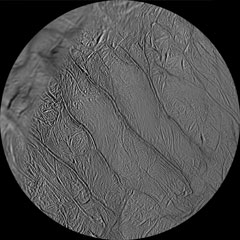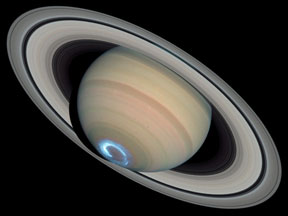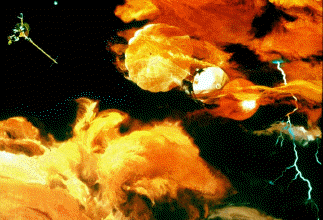Click on image for full size
Image courtesy of DLR and NASA/JPL/Cassini Imaging Team.
The South Pole of Enceladus
Enceladus is a medium-sized, icy moon of Saturn. The South Pole of Enceladus is one of the strangest places in the Solar System. Temperatures near the pole are far warmer than anywhere else on the moon. Huge cracks criss-cross the region and geysers spew ice crystals hundreds of kilometers into the sky.
Several huge gouges, more than 100 km (62 miles) long, run across the region of Enceladus's southern pole. These giant cracks have been nicknamed "tiger stripes". Scientists can tell that the area around the South Pole is geologically younger than the rest of the moon's surface. They have also discovered that the South Pole is by far the warmest place on the moon, especially near the tiger stripes. That wouldn't be so if the only source of heat on Enceladus is sunlight. The young surface, enormous "tiger stripe" cracks, and high temperatures all indicate that Enceladus (or at least the area around its South Pole) is geologically active.
The Cassini spacecraft found evidence of geologic activity. It took pictures of ice geysers erupting from the southern polar region of Enceladus! There are only four bodies in our Solar System on which we have seen eruptions - Jupiter's moon Io, Neptune's moon Triton, Earth (of course!), and now Enceladus. Scientists are still trying to figure out how the "plumbing" of the geysers works and what supplies heat for the geysers. There might be liquid water beneath the surface on Enceladus. That is an idea that gets astrobiologists excited.
Scientists have spotted several different plumes of ice from geysers. The ice crystals are flung hundreds of kilometers above Enceladus's surface. Some even leave the moon altogether, supplying icy material to one of Saturn's rings. Ice that falls back to the moon's surface covers it with a bright layer like fresh snow. This makes Enceladus the most reflective body in the Solar System.















